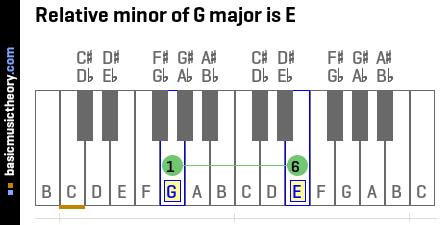G relative minor
The Solution below shows the relative minor key of the G major scale on the piano, treble clef and bass clef.
The Lesson steps then shows the note relationship between the major and its relative minor, and how to calculate the relative major from a minor scale.
For a quick summary of this topic, have a look at Relative minor.
| Sharps/flats | 0 | 1# | 2# | 3# | 4# | 5# | 6# | 7# | 1b | 2b | 3b | 4b | 5b | 6b | 7b |
|---|---|---|---|---|---|---|---|---|---|---|---|---|---|---|---|
| Key | C | [G] | D | A | E | B | F# | C# | F | Bb | Eb | Ab | Db | Gb | Cb |
Solution
1. Relative minor of G major is E
The 6th note of the G major scale is E, which identifies the tonic note of the relative (natural) minor key.
So the name of the G major scale relative minor is the E natural minor scale.

Below are both notes shown first on the treble clef, then on the bass clef.


 Bass Clef
Bass Clef
 Treble Clef
Treble Clef
Lesson steps
1. Piano key note names
The white keys are named using the alphabetic letters A, B, C, D, E, F, and G, which is a pattern that repeats up the piano keyboard.
Every white or black key could have a flat(b) or sharp(#) accidental name, depending on how that note is used. In a later step, if sharp or flat notes are used, the exact accidental names will be chosen.

The audio files below play every note shown on the piano above, so middle C (marked with an orange line at the bottom) is the 2nd note heard.
 Bass Clef
Bass Clef
 Treble Clef
Treble Clef
2. G major scale note interval positions
The major scale uses the W-W-H-W-W-W-H note counting rule to identify the scale note positions.
To count up a Whole tone, count up by two physical piano keys, either white or black.
To count up a Half-tone (semitone), count up from the last note up by one physical piano key, either white or black.
The tonic note (shown as *) is the starting point for identifying the notes in the scale.

 Bass Clef
Bass Clef
 Treble Clef
Treble Clef
3. The 6th note in the G major scale

The note names of this major scale are: G, A, B, C, D, E, F#, G.
The 6th note of this major scale is E, which identifies the tonic / starting note of the relative minor key.
So the name of the relative minor key is the E natural minor scale.
4. E natural minor note interval positions
The natural minor scale uses the W-H-W-W-H-W-W note counting rule to identify the scale note positions.
To count up a Whole tone, count up by two physical piano keys, either white or black.
To count up a Half-tone (semitone), count up from the last note up by one physical piano key, either white or black.
The tonic note (shown as *) is the starting point for identifying the notes in the scale.

 Bass Clef
Bass Clef
 Treble Clef
Treble Clef
5. E natural minor scale note names

The note names of this natural minor scale are: E, F#, G, A, B, C, D, E
The white and black keys are the same as those used in Step 3 above, which is why it is called the relative minor - the two scales have the same note names.
The difference between a major scale and the relative minor is that the notes are played starting from a different note, and they sound different to each other because different intervals were used to build each scale (Steps 2 and 4 above).
The major scale will sound happier than the relative minor because it separates notes 2 and 3 with a whole tone (2 piano keys), whereas the relative minor only has one half-tone / semitone (1 piano key) separating them, which gives a sadder feel to the scale.
 Bass Clef
Bass Clef
 Treble Clef
Treble Clef
6. Relative major of E minor scale
As described above, the music theory term relative major refers to the natural minor scale having the same notes as the major scale we know about.
But given any natural minor scale, it is possible to identify the relative major scale having the same notes.
To do this, just identify the 3rd note of the natural minor scale.
Using the minor scale in the previous step as an example, the third note is G,which is the key of the relative major we want.
So the relative major scale in this case is G major scale.
Related Keys and Topics
| Sharps/flats | 0 | 1# | 2# | 3# | 4# | 5# | 6# | 7# | 1b | 2b | 3b | 4b | 5b | 6b | 7b |
|---|---|---|---|---|---|---|---|---|---|---|---|---|---|---|---|
| Key | C | [G] | D | A | E | B | F# | C# | F | Bb | Eb | Ab | Db | Gb | Cb |